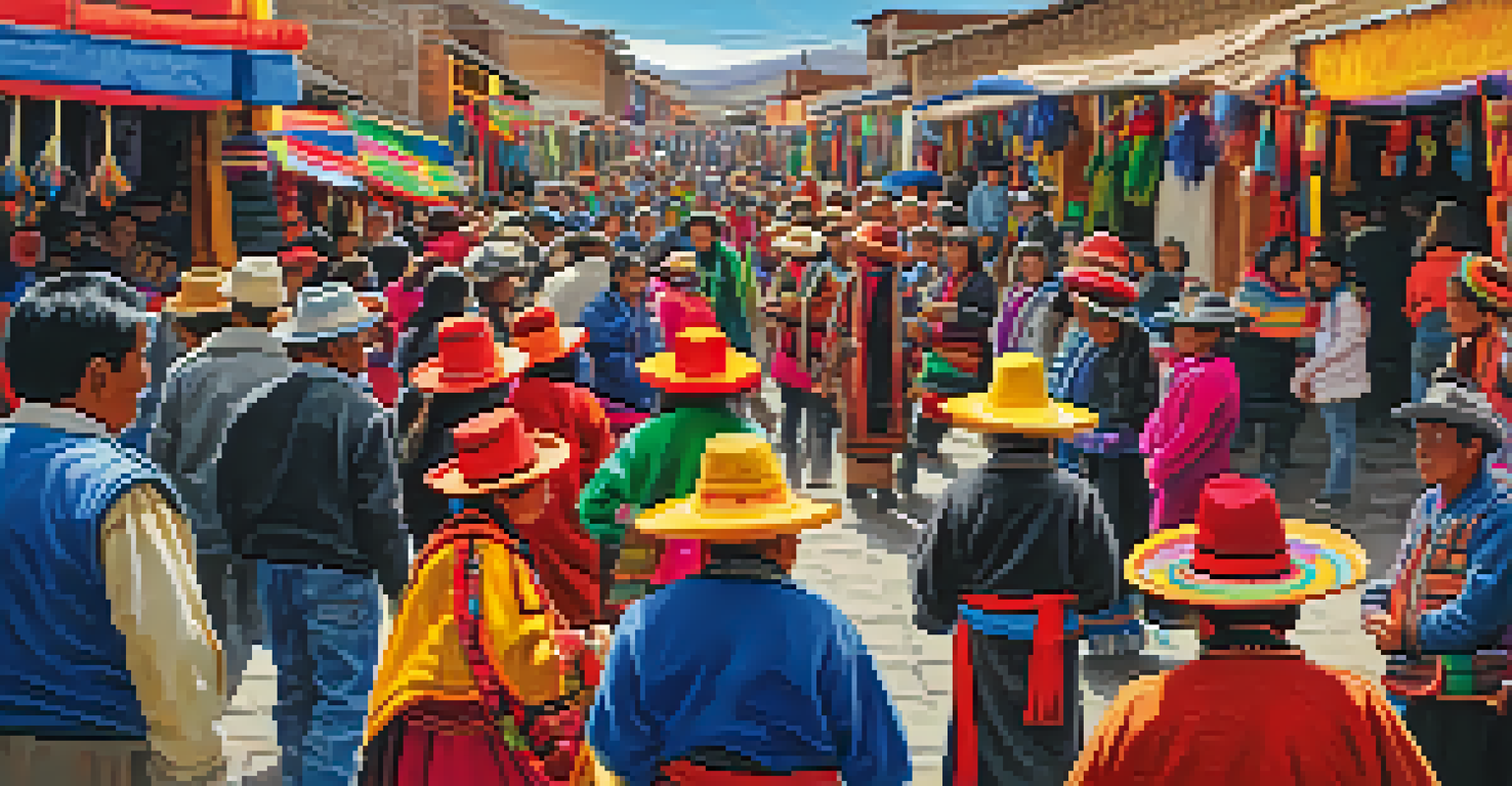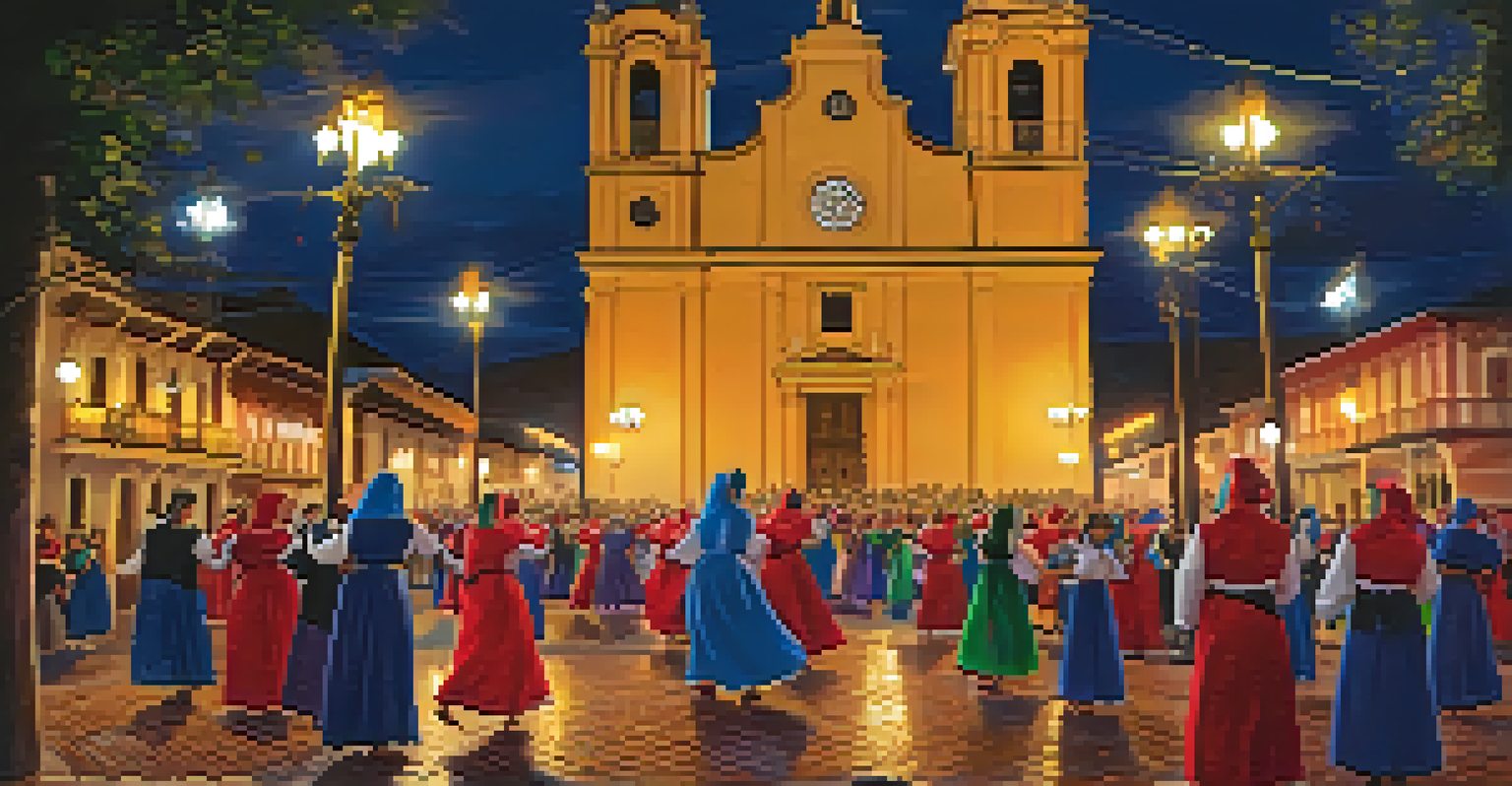The Role of Festivals in Shaping Peru's Tourist Experiences

Festivals as Cultural Showcases of Peru's Heritage
Peru is a tapestry of rich traditions, and its festivals are vibrant threads woven into the cultural fabric. These celebrations often reflect the country's deep-rooted history, from ancient Incan rituals to Spanish colonial influences. Tourists are drawn to Peru not just for its breathtaking landscapes, but for the opportunity to witness these unique cultural showcases that tell stories of the past.
Festivals are a way of preserving the cultural heritage of a community, and they enable us to reflect on who we are and where we come from.
For example, the Inti Raymi festival, held in Cusco, honors the Incan sun god with colorful parades and traditional dances. Visitors can immerse themselves in this historical reenactment, experiencing the grandeur of Incan culture firsthand. This connection to the past creates a deeper appreciation for Peru's heritage, making the travel experience truly memorable.
Moreover, these festivals encourage local communities to come together, fostering a sense of pride and belonging. Tourists often find themselves participating in these celebrations, creating connections with locals that enhance their understanding of Peruvian culture. Such interactions not only enrich the tourist experience but also promote cultural exchange.
Economic Impact of Festivals on Local Tourism
Festivals play a significant role in boosting local economies, particularly through tourism. When events like the Carnival of Cajamarca or the Feast of Corpus Christi occur, they attract thousands of visitors who spend on accommodations, food, and souvenirs. This influx of tourists can be a lifeline for small businesses, providing much-needed revenue during off-peak seasons.

For instance, local artisans often showcase their crafts during festivals, allowing tourists to purchase authentic Peruvian products. This not only supports the economy but also helps preserve traditional crafts that may otherwise fade away. By investing in local culture, tourists contribute to the sustainability of these communities.
Festivals Showcase Peru's Heritage
Peru's vibrant festivals reflect its rich cultural tapestry, blending ancient traditions with modern celebrations that engage both locals and tourists.
Additionally, the economic benefits extend beyond immediate financial gains; they help promote Peru as a vibrant tourist destination. Increased visibility through festive events can lead to year-round tourism, as visitors return to experience the culture and beauty of Peru outside of festival dates. This cyclical benefit underscores the importance of festivals in shaping Peru's tourism landscape.
Festivals as Opportunities for Cultural Exchange
Festivals in Peru offer a unique platform for cultural exchange, where locals and tourists alike come together to celebrate. Events like the Feast of San Juan invite tourists to join in traditional dances, tastes, and rituals, breaking down barriers and fostering understanding. Such experiences allow visitors to not just observe, but actively participate in the culture, creating lasting memories.
Travel is more than just visiting a place; it's about making connections and creating memories that last a lifetime.
Through these interactions, tourists gain insights into Peruvian values and traditions, while locals can share their stories and heritage. This two-way exchange enriches the travel experience, allowing for a more authentic understanding of Peru. It’s a beautiful reminder that travel is not just about the destinations, but the connections made along the way.
Moreover, this cultural exchange can inspire tourists to bring elements of Peruvian culture back to their home countries. Whether it's a new recipe learned during a festival or a dance they participated in, these experiences often spark a lasting interest in Peru and its traditions. This ripple effect can lead to increased cultural appreciation and interest in Peru as a travel destination.
Unique Festivals That Define Peru's Identity
Peru boasts an array of unique festivals that capture the country's diverse cultural identity. From the vibrant colors of the Fiesta de la Candelaria in Puno to the solemnity of the Day of the Dead, each event highlights different aspects of Peruvian life. These festivals not only celebrate religious and historical events but also showcase regional diversity through local customs and traditions.
Take, for example, the National Festival of the Pisco Sour, which celebrates Peru's national drink. This festival not only draws attention to the beverage but also highlights the country's rich agricultural heritage, as Pisco is made from locally grown grapes. Such events provide tourists with a taste of Peru’s culinary delights while immersing them in its cultural narrative.
Economic Boost from Festivals
Festivals significantly enhance local economies by attracting tourists who spend on accommodations, food, and crafts, supporting small businesses.
These unique festivals play a vital role in defining Peru’s identity on the global stage. They invite the world to partake in the richness of Peruvian culture, fostering a sense of pride among locals and intrigue among tourists. As visitors share their experiences, they help to amplify Peru's cultural significance, making it a must-visit destination.
The Role of Festivals in Promoting Sustainable Tourism
Sustainable tourism is increasingly important in today's travel landscape, and festivals in Peru are leading the way in promoting this concept. Many festivals focus on environmental awareness, showcasing local practices that prioritize sustainability. For instance, during the Festival of the Earth, various activities highlight the importance of natural resources and conservation efforts.
This commitment to sustainability not only attracts eco-conscious travelers but also encourages local communities to adopt greener practices. By participating in these festivals, tourists learn about the environmental challenges Peru faces, fostering a sense of responsibility and appreciation for the natural world. This education can inspire visitors to make more sustainable choices in their own lives.
Moreover, as festivals promote local traditions and sustainable practices, they help preserve the cultural heritage of Peru for future generations. Tourists increasingly seek experiences that are not only enjoyable but also contribute positively to the communities they visit. Festivals that emphasize sustainability ensure that Peru's rich culture and stunning landscapes remain intact for years to come.
Festivals as a Bridge Between Generations
In many Peruvian families, festivals serve as a bridge connecting generations, allowing traditions to be passed down through storytelling and participation. Elders share their knowledge of customs and rituals with the younger generation during these celebrations, instilling a sense of pride and continuity. This intergenerational exchange enriches the cultural fabric of Peru, ensuring that its vibrant traditions endure.
For tourists, witnessing this bond between generations can be both heartwarming and eye-opening. Participating in activities led by families during festivals often provides a deeper understanding of the significance behind each ritual. Such experiences create a sense of shared humanity and foster respect for cultural diversity.
Cultural Exchange Through Celebrations
These events foster meaningful cultural exchanges, allowing tourists to actively participate in local traditions while gaining a deeper understanding of Peruvian culture.
This connection between generations is particularly evident during festivals like the Festival of the Virgin of Candelaria, where families come together to perform traditional dances and music. Tourists are invited to join in, creating a unique opportunity for cultural immersion. These moments, filled with joy and learning, highlight the importance of festivals in preserving tradition and building connections across ages.
The Future of Festivals in Peru's Tourism Landscape
As Peru continues to grow as a tourist destination, the future of its festivals looks promising. Organizers are increasingly recognizing the need to innovate while maintaining the authenticity of these celebrations. This balance will be crucial in attracting a new generation of travelers who are eager for unique, immersive experiences.
Moreover, the integration of technology into festivals can enhance the tourist experience. Virtual reality tours of historical events or live streaming performances can reach a global audience, allowing even those who cannot travel to experience the magic of Peruvian festivals. This expansion can increase interest in visiting Peru, leading to even greater participation in these vibrant celebrations.

However, it's essential to approach this future with care, ensuring that festivals remain true to their roots and continue to benefit local communities. By prioritizing sustainability and cultural integrity, Peru can ensure that its festivals continue to thrive, offering enriching experiences for tourists and locals alike for generations to come.